These regions will dictate the electoral outcome in Pennsylvania. For Republicans, success will depend on winning back enough suburban professionals in places like Hershey, which favored Trump in 2016, and courting Trump-to-Biden voters, much as the former president relied on working-class Obama voters in 2016. For Democrats, high voting margins among suburbanites would have to expand into growing residential communities—often filled with upper-middle-class New York transplants—in northeastern Pennsylvania’s Schuylkill and Luzerne Counties, and the Poconos.
The GOP faces a challenge in this region on health care, which looms large among suburban professionals but also for aging working-class residents dealing with chronic health issues and medical debt. This is the case in Luzerne, where the health system Geisinger recently announced a $900 million expansion. “We’re taking care of more people than ever before,” one Geisinger official noted in a press release, “and those we treat in the emergency room are sicker than they’ve ever been.”
Many working-class voters, including in Hazleton and Reading, no longer view the Democratic Party as representing their economic interests. This follows years of intensifying suspicion of the party in regions like the northeast and parts of the Lehigh Valley. In Luzerne, Democrats are now seen as the party of the technocratic class that supported NAFTA and globalization. In the 2000s, both parties were regarded with suspicion on issues like illegal immigration and the Iraq War. Trump tapped into this frustration. In the Covid era, working-class Latino and white residents have endured rising prices as both consumers and businessowners. Democrats’ trumpeting of positive economic data does not align with the financial realities of voters in these areas.
 On Election Day, the state’s political realignment will be tested not in Philadelphia or Pittsburgh but in regions that represent the most demographically complex expanse among the swing states. The 2024 election will measure just how blue the suburbs are turning around south-central cities Harrisburg and Lancaster, while Republicans will rely not only on historic margins among Latino voters but also on working-class residents who still voted Democratic as recently as a decade ago.
Whatever happens on November 5, one thing is certain: this is not “Alabama.”
Charles F. McElwee is the founding editor of RealClearPennsylvania. He is a contributing writer at POLITICO Magazine. Follow him on X at @CFMcElwee.
Photo by RYAN COLLERD/AFP via Getty Images
Source link : http://www.bing.com/news/apiclick.aspx?ref=FexRss&aid=&tid=6713df04d92a49d6b2f8fff980e9365d&url=https%3A%2F%2Fwww.city-journal.org%2Farticle%2Ftime-to-retire-pennsylvanias-alabama&c=9061945362179947413&mkt=en-us
Author :
Publish date : 2024-10-19 01:38:00
Copyright for syndicated content belongs to the linked Source.












